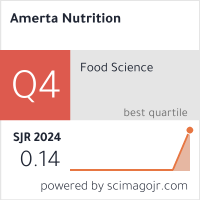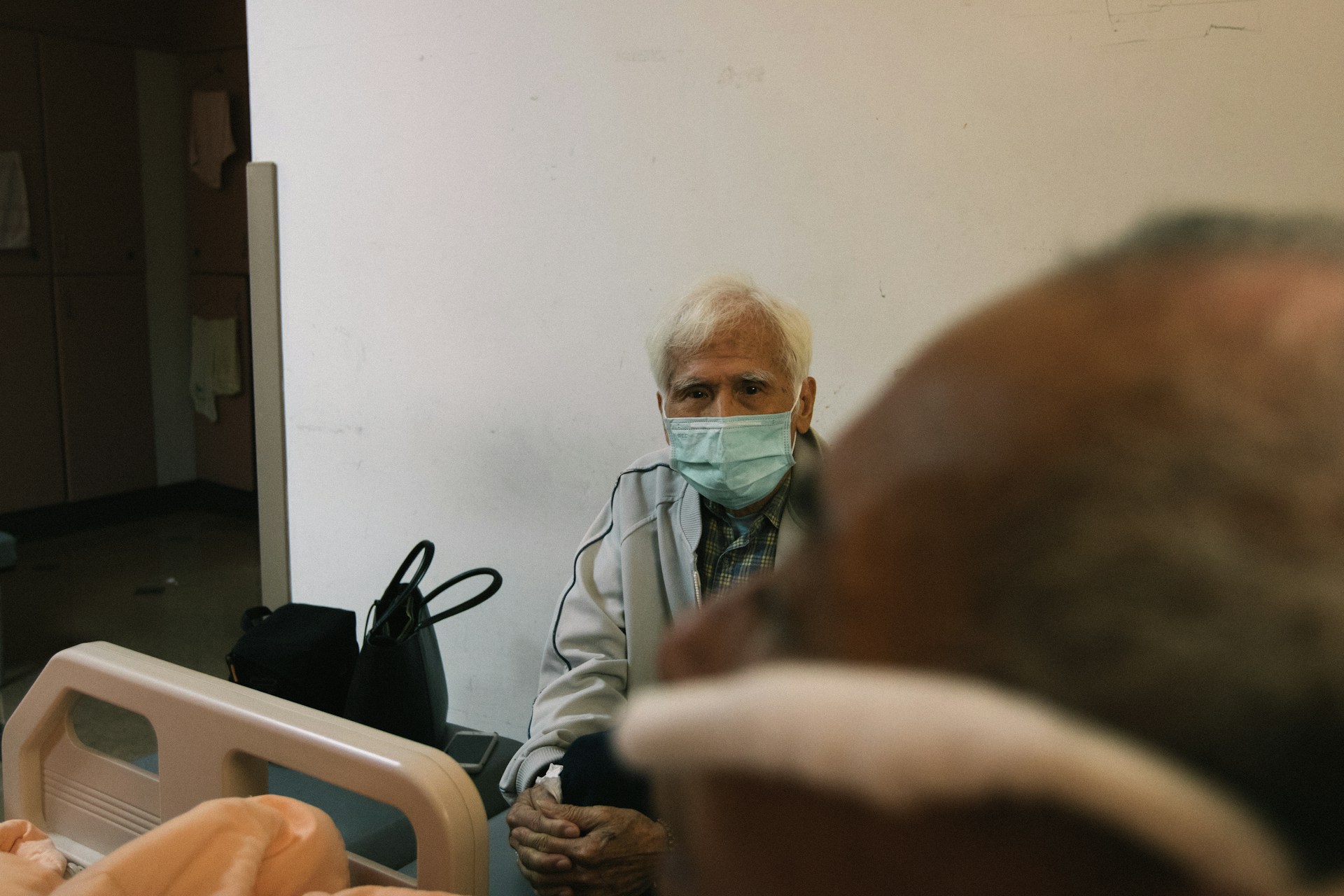Relationship between Body Mass Index, Body Fat Percentage, and Eating Habits among University Students in Malang
Hubungan Antara Indeks Massa Tubuh dan Persen Lemak Tubuh dengan Kebiasaan Makan pada Mahasiswa di Malang

Background: In 2023, obesity prevalence in Indonesia was reported at 15.7% in men and 31.2% in women. Eating out has become increasingly common among university students in major cities like Malang due to busy schedules, easy access to food accessibility, and lifestyle changes.
Objectives: This study aims to examine the relationship between Body Mass Index (BMI), body fat percentage, and eating habits among university students.
Methods: This cross-sectional observational study was conducted at Universitas Brawijaya, Malang, involving 385 respondents. The measured variables included BMI, body fat percentage, and eating habits. Eating habits were assessed using a questionnaire covering five indicators: Takeaway food consumption, eating at home, dining at restaurants, consuming supermarket food, and consuming traditional market snacks. Data were analyzed using the Chi-square test and Logistic Regression.
Results: Most respondents were female, lived in dormitories or rented housing, and had a family income below five million rupiahs per month. Among the five eating habit indicators, only restaurant dining showed a significant correlation with BMI and body fat percentage (p-value<0.05), while takeaway food consumption, eating at home, consuming supermarket food, and consuming traditional market snacks were not significantly related (p-value>0.05).
Conclusions: Eating habits, in general, showed no significant relationship with BMI and body fat percentage, except for restaurant dining, which was significantly correlated with increased body fat percentage.
Witono, S. K., Nugraha, G. I., Permana, H. & Adi, S. Profil Massa Lemak dan Lingkar Pinggang Dewasa Obes dan Nonobes di Cirebon. Glob. Med. Heal. Commun. 6, 7–11 (2018). https://doi.org/10.29313/gmhc.v6i1.2192.
Kemenkes & BKPK. Survei Kesehatan Indonesia (SKI) Dalam Angka. Kementerian Kesehatan Republik Indonesia vol. 1 (2023). https://www.badankebijakan.kemkes.go.id/ski-2023-dalam-angka/.
Badan Penelitian Dan Pengembangan Kesehatan Republik Indonesia. Laporan Riskesdas 2018 Nasional. Lembaga Penerbit Balitbangkes 674 (2018). https://repository.badankebijakan.kemkes.go.id/id/eprint/3514/.
Colozza, P. Colozza, David. Padmita, Astrid Citra. (2018) Analisis Lanskap Kelebihan Berat Badan & Obesitas di Indonesia. UINCEF Indonesia. 01 Desember 2022 1–134 (2019). http://unicef.org/indonesia/media/15581/file/AnalisisLanskapKelebihanBeratBadandanObesitasdiIndonesia.pdf.
Mizia, S., Felińczak, A., Włodarek, D. & Syrkiewicz-świtała, M. Evaluation of eating habits and their impact on health among adolescents and young adults: A cross-sectional study. Int. J. Environ. Res. Public Health 18, (2021). https://doi.org/10.3390/ijerph18083996.
Riadipa, N. G. A. P. S., Suiraoka, I. P. & Purnadhibrata, I. M. Konsumsi Makanan Siap Saji dan Status Obesitas pada Anak Usia Sekolah Dasar di SD Negeri 03 Penatih dan SD Negeri 17 Dangin Puri di Kota Denpasar. 131–137 (2018). http://repository.poltekkes-denpasar.ac.id/id/eprint/829.
Pradiningtyas, F. & Ismawati, R. Hubungan Pengetahuan Pola Makan Sehat Dengan Kebiasaan Makan Remaja Kelas 12 SMA Negeri 1 Tarik di Masa Pandemi COVID-19. J. Gizi Univ. Negeri Surabaya 3, 267–272 (2020). https://ejournal.unesa.ac.id/index.php/GIZIUNESA/article/view/50655.
Albalawi, A. A., Hambly, C. & Speakman, J. R. Consumption of takeaway and delivery meals is associated with increased BMI and percent fat among UK Biobank participants. Am. J. Clin. Nutr. 116, 173–188 (2022). https://doi.org/10.1093/ajcn/nqac078.
Madden, A. M. & Smith, S. Body composition and morphological assessment of nutritional status in adults: A review of anthropometric variables. J. Hum. Nutr. Diet. 29, 7–25 (2016). https://doi.org/10.1111/jhn.12278.
WHO. Obesity Task Force). International Association for the Study of Obesity. The Asia – Pacific perspective: redefining obesity and its treatment. 56 (2000). https://iris.who.int/handle/10665/206936.
Petˇ, K., Borzenko, N., Kovalov, M. & Gottfriedov, N. Assessment of Body Mass Index , Body Composition , Physical Activity , and Dietary Preferences in University Students : A Pilot Study. 35–44 (2024). https://doi.org/10.3390/obesities4010004.
Jahang, R. S., Wahyuningsih, S. & Rahmuniyati, M. E. Hubungan Pengetahuan dan Penggunaan Layanan Delivery Makanan Online Konsumsi Makanan Cepat Saji pada Mahasiswa Gizi Universitas Respati Yogyakarta. J. Formil (Forum Ilmiah) Kesmas Respati 6, 199 (2021). https://doi.org/10.35842/formil.v6i2.374.
Tariq, S., Tariq, S. & Tariq, S. Association of perceived stress with healthy and unhealthy food consumption among teenagers. J. Pak. Med. Assoc. 69, 1817–1821 (2019). https://doi.org/10.5455/jpma.302642278.
Banik, R., Naher, S., Pervez, S. & Hossain, M. M. Fast food consumption and obesity among urban college going adolescents in Bangladesh: A cross-sectional study. Obes. Med. 17, 100161 (2020). https://doi.org/10.1016/j.obmed.2019.100161.
Mahajan, S. A. & Gothankar, J. S. Fast food consumption pattern amongst undergraduates of various disciplines of private colleges in Pune. Int. J. Community Med. Public Heal. 7, 505 (2020). https://doi.org/10.18203/2394-6040.ijcmph20196069.
Santoso, B. & Velania, V. Hubungan Tingkat Pengetahuan Tentang Makanan Cepat Saji Dengan Pola Konsumsinya Pada Mahasiswa Tingkat Ii Akper Panti Kosala Surakarta. KOSALA J. Ilmu Kesehat. 5, 31–36 (2017). https://doi.org/10.37831/jik.v5i1.115.
Munasiroh, D., Nurawali, D. O., Rahmah, D. A., Suhailah, F. & Yusup, I. R. Faktor-Faktor Yang Berhubungan Dengan Perilaku Konsumsi Makanan Cepat Saji (Fast Food) Pada Mahasiswa. An-Nadaa J. Kesehat. Masy. 6, (2019). https://doi.org/10.31602/ann.v6i2.2681.
Jauziyah, S., Nuryanto, N., Tsani, A. F. A. & Purwanti, R. Pengetahuan Gizi Dan Cara Mendapatkan Makanan Berhubungan Dengan Kebiasaan Makan Mahasiswa Universitas Diponegoro. J. Nutr. Coll. 10, 72–81 (2021). https://doi.org/10.14710/jnc.v10i1.30428.
Omidvar S, B. K. Dietary Pattern , Food Habits and Preferences Among Adolescent and Adult Student Girls From an Urban. 4, 465–473 (2014). https://www.researchgate.net/publication/263852374_.
Halid, M. Sudargo, T. Hubungan Status Sosial Ekonomi dengan Tingkat Konsumsi Fast Food pada Remaja di Kota Mataram. BIOTA J. Tadris IPA Biol. UIN Mataram 8, 74–85 (2016). https://doi.org/10.20414/jb.v9i1.37.
Pemayun, T. I. R. P. & Saraswati, I. M. R. Gambaran Kebiasaan Mengonsumsi Makanan Cepat Saji dan Obesitas pada Mahasiswa Semester V Program Studi Kedokteran Umum Universitas Udayana Tahun 2014. Intisari Sains Medis 4, 284–290 (2014). https://doi.org/10.15562/ism.v4i1.44.
Mahmoud, M. H. & Taha, A. S. The Association between Eating Habits and Body Mass Index among Nursing Students. IOSR J. Nurs. Heal. Sci. 06, 14–26 (2017). https://doi.org/10.9790/1959-0603061426.
Mahfouz, M. S. et al. Nutritional Habits and Weight Status among Jazan University Students : Eating Patterns and Healthy lifestyle Assessment. Epidemiol. Biostat. Public Heal. 13, 1–7 (2016). https://doi.org/10.2427/11658.
Patarru, F., Situngkir, R. S., Heumasse, C. F. & Ahudara, C. G. S. Kebiasaan Konsumsi Makanan Siap Saji (Fast Food) dan Status Gizi pada Remaja. J. Penelit. Kesehat. Suara Forikes 13, 234–237 (2022). http://dx.doi.org/10.33846/sf13nk143.
Rayahu, A. ., Apriningrum, M. & Marlina, R. Hubungan antara Kebiasaan Makan perhari, Asupan Karbohidrat dan Asupan Serat dengan Persentase Lemak Tubuh pada Mahasiswa dan Dosen Prodi Kebidanan Fakultas Ilmu Kesehatan Unsika. Heal. Sci. Growth J. 1, 116–121 (2017). https://journal.unsika.ac.id/index.php/HSG/article/view/1088/910.
Arraniri, M., Desmawati, D. & Aprilia, D. Hubungan Kebiasaan Sarapan dan Asupan Kalori dengan Persentase Lemak Tubuh pada Mahasiswa Prodi Profesi Dokter Fakultas Kedokteran Universitas Andalas Angkatan 2013-2015. J. Kesehat. Andalas 6, 265 (2017). https://doi.org/10.25077/jka.v6i2.689.
Goffe, L., Rushton, S., White, M., Adamson, A. & Adams, J. Relationship between mean daily energy intake and frequency of consumption of out-of-home meals in the UK National Diet and Nutrition Survey. Int. J. Behav. Nutr. Phys. Act. 14, 1–11 (2017). https://doi.org/10.1186/s12966-017-0589-5.
Burgoine, T., Forouhi, N. G., Griffin, S. J., Wareham, N. J. & Monsivais, P. Associations between exposure to takeaway food outlets, takeaway food consumption, and body weight in Cambridgeshire, UK: Population based, cross sectional study. BMJ 348, 1–10 (2014). https://doi.org/10.1136/bmj.g1464.
Astbury, C. C., Penney, T. L. & Adams, J. Comparison of individuals with low versus high consumption of home-prepared food in a group with universally high dietary quality: A cross-sectional analysis of the UK National Diet & Nutrition Survey (2008-2016). Int. J. Behav. Nutr. Phys. Act. 16, 1–15 (2019). https://doi.org/10.1186/s12966-019-0768-7.
Jones, S. A., Walter, J., Soliah, L. A. & Phifer, J. T. Perceived motivators to home food preparation: Focus group findings. J. Acad. Nutr. Diet. 114, 1552–1556 (2014). https://doi.org/10.1016/j.jand.2014.05.003.
Kabir, A., Miah, S. & Islam, A. Factors influencing eating behavior and dietary intake among resident students in a public university in Bangladesh: A qualitative study. PLoS One 13, 1–17 (2018). https://doi.org/10.1371/journal.pone.0198801.
Deric, D. H., Godfrey, E. & Quaicoe, O. Food Sources and Preferences of College Students. Eur. Sci. J. 7–8 (2017) doi:10.19044/esj.2017.c1p7. http://dx.doi.org/10.19044/esj.2017.c1p7.
Harris, J., Nguyen, P. H., Tran, L. M. & Huynh, P. N. Nutrition transition in Vietnam: changing food supply, food prices, household expenditure, diet and nutrition outcomes. Food Secur. 12, 1141–1155 (2020). https://doi.org/10.1007/s12571-020-01096-x.
Nur Faizah, N. A. & Ruhana, A. Persepsi Body Image Dengan Kebiasaan Jajan Mahasiswa Universitas Negeri Surabaya (Kampus Ketintang). J. Sehat Mandiri 16, 172–184 (2021). https://doi.org/10.33761/jsm.v16i1.376.
Muhandri, T., Hasanah, U. & Amanah, A. Perilaku Konsumen Terhadap Jajanan Tradisional di Kabupaten. Pekalongan. J. Mutu Pangan Indones. J. Food Qual. 8, 10–16 (2021). https://doi.org/10.29244/jmpi.2021.8.1.10
Jiang, Y. et al. Association between take-out food consumption and obesity among chinese university students: A cross-sectional study. Int. J. Environ. Res. Public Health 16, (2019). https://doi.org/10.3390/ijerph16061071.
Janssen, H. G., Davies, I. G., Richardson, L. D. & Stevenson, L. Determinants of takeaway and fast food consumption: A narrative review. Nutr. Res. Rev. 31, 16–34 (2018). https://doi.org/10.1017/S0954422417000178.
Kegler, M. C., Hermstad, A. & Haardörfer, R. Home food environment and associations with weight and diet among U.S. adults: a cross-sectional study. BMC Public Health 21, 1–10 (2021). https://doi.org/10.1186/s12889-021-11102-2.
Rosenthal, R. & Raynor, H. The effect of television watching and portion size on intake during a meal. Appetite 117, 191–196 (2017). https://doi.org/10.1016/j.appet.2017.06.030.
Mills, S., Brown, H., Wrieden, W., White, M. & Adams, J. Frequency of eating home cooked meals and potential benefits for diet and health: Cross-sectional analysis of a population-based cohort study. Int. J. Behav. Nutr. Phys. Act. 14, 1–11 (2017). https://doi.org/10.1186/s12966-017-0567-y.
Zang, J. et al. Eating Out-of-Home in Adult Residents in Shanghai and the Nutritional Differences among Dining Places. 1–13 (2018) doi:10.3390/nu10070951. https://doi.org/10.3390/nu10070951.
Wellard-Cole, L., Davies, A. & Allman-Farinelli, M. Contribution of foods prepared away from home to intakes of energy and nutrients of public health concern in adults: a systematic review. Crit. Rev. Food Sci. Nutr. 62, 5511–5522 (2022). https://doi.org/10.1080/10408398.2021.1887075.
Bhutani, S., Schoeller, D. A., Walsh, M. C. & McWilliams, C. Frequency of Eating Out at Both Fast-Food and Sit-Down Restaurants Was Associated With High Body Mass Index in Non-Large Metropolitan Communities in Midwest. Am. J. Heal. Promot. 32, 75–83 (2018). https://doi.org/10.1177/0890117116660772.
Ardin, H., Kartini, S. D., Lestari, T. S. & Retno. Hubungan Kebiasaan Makan Fast Food dan Asupan Zat Gizi Makro Dengan Status Gizi Remaja. Zat Gizi Makro 25, 95–103 (2018). https://perpus.poltekkes-mks.ac.id/opac/detail-opac?id=5315.
Dubowitz, T. et al. A New Supermarket in a Food Desert: Is Better Health in Store? (RAND Corporation, 2015). https://doi.org/10.7249/rb9874.
Coelestia, A. A. G. & Isodarus, P. B. Dasar Penamaan Kue Jajanan Pasar Di Pasar Lempuyangan. Sintesis 15, 1–16 (2021). https://doi.org/10.24071/sin.v15i1.312347.
Fitri, Y., Al Rahmad, A. H., Suryana, S. & Nurbaiti, N. Pengaruh penyuluhan gizi tentang jajanan tradisional terhadap peningkatan pengetahuan dan perilaku jajan anak sekolah. AcTion Aceh Nutr. J. 5, 13 (2020). https://doi.org/10.30867/action.v5i1.18648.
Sutanto, D. H., Estikowati & Setioko, M. D. Pelestarian Jajanan Tradisional Sebagai Upaya Untuk Memperkuat Wisata Kuliner Kota Malang. Semin. Nas. Kepariwisataan 1, 142–146 (2020). https://seminar.unmer.ac.id/index.php/senorita/SENORITA/paper/view/519.
Wulansari, M. D. R., Nursanyoto, H. & Suiraoka, I. P. Pola Konsumsi Jajanan Dan Kejadian Obesitas Remaja Di Smp Negeri 3 Sukawati. J. Nutr. Sci. 10, 170–177 (2021). https://doi.org/10.33992/jig.v10i3.1151.
Luthfiya, L. & Nabawiyah, H. Hubungan konsumsi makanan jajanan terhadap obesitas sentral sada Mahasisiwi berbasis pesantren. Arsip Gizi dan Pangan 7, 1–8 (2022). https://doi.org/10.22236/argipa.v7i1.8087.
Hoenink, J. et al. OP80 The effect of environmental exposure to food takeaways and its interaction with eating behaviour traits on takeaway food consumption and body fat. J. Epidemiol. Community Health 76, A39 LP-A39 (2022). https://doi.org/10.1136/jech-2022-SSMabstracts.79.
Hoenink, J. C. et al. The moderating role of eating behaviour traits in the association between exposure to hot food takeaway outlets and body fatness. Int. J. Obes. 47, 496–504 (2023). https://doi.org/10.1038/s41366-023-01290-9.
Wei, X., Yu, D., Ju, L., Cheng, X. & Zhao, L. Analysis of the correlation between eating away from home and bmi in adults 18 years and older in china: Data from the cnnhs 2015. Nutrients 14, (2022). https://doi.org/10.3390/nu14010146.
Lee, J. et al. Are patterns of family evening meal practices associated with child and parent diet quality and weight-related outcomes? Appetite 171, 1–18 (2022). https://doi.org/10.1016/j.appet.2022.10593755.
Pescari, D., Mihuta, M. S. & Bena, A. Comparative Analysis of Dietary Habits and Obesity Prediction : Body Mass Index versus Body Fat Percentage Classification Using Bioelectrical Impedance Analysis. (2024). https://doi.org/10.3390/nu16193291.
Gesteiro, E., García-Carro, A., Aparicio-Ugarriza, R. & González-Gross, M. Eating out of Home: Influence on Nutrition, Health, and Policies: A Scoping Review. Nutrients 14, 1–15 (2022). https://doi.org/10.3390/nu14061265.
Schultz, S. et al. Availability and placement of healthy and discretionary food in Australian supermarkets by chain and level of socio-economic disadvantage. Public Health Nutr. 24, 203–214 (2021). https://doi.org/10.1017/S1368980020002505.
Li, Y. et al. Grocery store access and childhood obesity: A systematic review and meta-analysis. Obesity Reviews vol. 22 (2021). https://doi.org/10.1111/obr.1294559. Andarwulan, N. et al. Food consumption pattern and the intake of sugar, salt, and fat in the South Jakarta City—Indonesia. Nutrients 13, 1–19 (2021). https://doi.org/10.3390/nu13041289.
Hafiza, D., Utmi, A. & Niriyah, S. Hubungan Kebiasaan Makan Dengan Status Gizi Pada Remaja Smp Ylpi Pekanbaru. Al-Asalmiya Nurs. J. Ilmu Keperawatan (Journal Nurs. Sci. 9, 86–96 (2021). https://doi.org/10.35328/keperawatan.v9i2.671.
Deliens, T., Clarys, P., Bourdeaudhuij, I. De & Deforche, B. Determinants of eating behaviour in university students : a qualitative study using focus group discussions. BMC Public Health 14, 1–12 (2014). https://doi.org/10.1186/1471-2458-14-53.
Copyright (c) 2025 Amerta Nutrition

This work is licensed under a Creative Commons Attribution-ShareAlike 4.0 International License.
AMERTA NUTR by Unair is licensed under a Creative Commons Attribution-ShareAlike 4.0 International License.
1. The journal allows the author to hold the copyright of the article without restrictions.
2. The journal allows the author(s) to retain publishing rights without restrictions
3. The legal formal aspect of journal publication accessibility refers to Creative Commons Attribution Share-Alike (CC BY-SA).
4. The Creative Commons Attribution Share-Alike (CC BY-SA) license allows re-distribution and re-use of a licensed work on the conditions that the creator is appropriately credited and that any derivative work is made available under "the same, similar or a compatible license”. Other than the conditions mentioned above, the editorial board is not responsible for copyright violation.












































